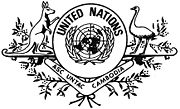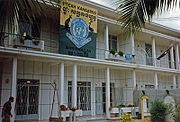
FCU UNTAC
Encyclopedia
FCU - UNTAC, the Force Communications Unit UNTAC (United Nations
Transitional Authority in Cambodia
), was the Australia
n component of the UNTAC mission in Cambodia.
 After Vietnam
After Vietnam
intervened in Cambodia in 1979 to overthrow the Khmer Rouge
regime, Cambodia became embroiled in a four-sided civil war
.
 The four groups were the Vietnamese-installed government of the State of Cambodia (SOC) which was supported by the Cambodian People's Armed Forces (CPAF); the communist Democratic Kampuchea
The four groups were the Vietnamese-installed government of the State of Cambodia (SOC) which was supported by the Cambodian People's Armed Forces (CPAF); the communist Democratic Kampuchea
(DK - commonly known as the Khmer Rouge
) which is supported by the National Army of Democratic Kampuchea
(NADK); and the two non communist factions, the Khmer People's National Liberation Front
(KPNLF) which was supported by Khmer People's National Liberation Armed Forces
(KPNLAF); and the United Front for an Independent, Neutral, Peaceful and Cooperative Cambodia (FUNCINPEC) which was supported by the National Army of Independent Cambodia (ANKI).
In August 1989, the UN proposed an observer mission to monitor the withdrawal of Vietnamese forces from Cambodia and supervise an internal peace process between the four factions. From 6–22 August 1989, two Australian officers were deployed to Thailand and Cambodia on the UN reconnaissance team planning the mission.
In late March 1992, UNTAC was established under the 1991 Paris Agreements to supervise a cease-fire and general election in Cambodia. Australian diplomacy during 1989–1991 assisted the successful conclusion of the Agreements.
. On 10 November 1991 45 Australian Army personnel flew to Cambodia as part of Australias advanced party to UNAMIC. The advanced party established an Australian HQ and provided basic radio communications to the 4 military factions headquarters. Australia contributed a 65-strong communications unit to its precursor, the UN Advance Mission in Cambodia (UNAMIC). The Australians (under the command of Lieutenant Colonel Russell Stuart) were among the first UN troops in Cambodia, to provide communications support to UNAMIC which was tasked to set in motion the peace process and pave the way for the deployment of UNTAC. UNAMIC's mandate ended in March 1992 and was absorbed into UNTAC at its establishment in United Nations Security Council Resolution 745
.

.
 Since 1991 when the original Australian UNAMIC contingent provided the communications network between the four Cambodian factions' military headquarters and the UNAMIC headquarters, the task of the Australians mushroomed under its UNTAC mandate. To achieve those tasks, the FCU based its RHQ in Phnom Penh (Pteah Kangaroo), along with the headquarters of its administrative squadron and 1 Sig Sqn (Pteah Australii). 2 Sig Sqn was based in the northern provincial capital of Battambang. The FCU was spread across 56 locations throughout Cambodia and was the only unit to serve in Cambodia to see more action than any other UN unit. Other major FCU locations included Siem Reap
Since 1991 when the original Australian UNAMIC contingent provided the communications network between the four Cambodian factions' military headquarters and the UNAMIC headquarters, the task of the Australians mushroomed under its UNTAC mandate. To achieve those tasks, the FCU based its RHQ in Phnom Penh (Pteah Kangaroo), along with the headquarters of its administrative squadron and 1 Sig Sqn (Pteah Australii). 2 Sig Sqn was based in the northern provincial capital of Battambang. The FCU was spread across 56 locations throughout Cambodia and was the only unit to serve in Cambodia to see more action than any other UN unit. Other major FCU locations included Siem Reap
, Kampong Som, Banteay Meanchey, Khu, Kampong Cham, Kampong Thom, Pailin
and Sisophon
.
 From 11 May to 9 September 1992, a Movement Control Group (MCG) comprising seven RAN, 16 Army and seven RAAF personnel joined UNTAC. The MCG included a headquarters and nine three person teams, and coordinated the reception and movement of forces during UNTAC's main deployment phase. From 15 May to 19 July 1993, Australia contributed a further 115 troops and six S70A Blackhawk helicopters, with the deployment of a squadron from 5 Aviation Regiment and an infantry platoon protection party from the 2/4th Battalion, the Royal Australian Regiment.
From 11 May to 9 September 1992, a Movement Control Group (MCG) comprising seven RAN, 16 Army and seven RAAF personnel joined UNTAC. The MCG included a headquarters and nine three person teams, and coordinated the reception and movement of forces during UNTAC's main deployment phase. From 15 May to 19 July 1993, Australia contributed a further 115 troops and six S70A Blackhawk helicopters, with the deployment of a squadron from 5 Aviation Regiment and an infantry platoon protection party from the 2/4th Battalion, the Royal Australian Regiment.

United Nations
The United Nations is an international organization whose stated aims are facilitating cooperation in international law, international security, economic development, social progress, human rights, and achievement of world peace...
Transitional Authority in Cambodia
Cambodia
Cambodia , officially known as the Kingdom of Cambodia, is a country located in the southern portion of the Indochina Peninsula in Southeast Asia...
), was the Australia
Australia
Australia , officially the Commonwealth of Australia, is a country in the Southern Hemisphere comprising the mainland of the Australian continent, the island of Tasmania, and numerous smaller islands in the Indian and Pacific Oceans. It is the world's sixth-largest country by total area...
n component of the UNTAC mission in Cambodia.
United Nations Transitional Authority in Cambodia

Vietnam
Vietnam – sometimes spelled Viet Nam , officially the Socialist Republic of Vietnam – is the easternmost country on the Indochina Peninsula in Southeast Asia. It is bordered by China to the north, Laos to the northwest, Cambodia to the southwest, and the South China Sea –...
intervened in Cambodia in 1979 to overthrow the Khmer Rouge
Khmer Rouge
The Khmer Rouge literally translated as Red Cambodians was the name given to the followers of the Communist Party of Kampuchea, who were the ruling party in Cambodia from 1975 to 1979, led by Pol Pot, Nuon Chea, Ieng Sary, Son Sen and Khieu Samphan...
regime, Cambodia became embroiled in a four-sided civil war
Civil war
A civil war is a war between organized groups within the same nation state or republic, or, less commonly, between two countries created from a formerly-united nation state....
.

Democratic Kampuchea
The Khmer Rouge period refers to the rule of Pol Pot, Nuon Chea, Ieng Sary, Son Sen, Khieu Samphan and the Khmer Rouge Communist party over Cambodia, which the Khmer Rouge renamed as Democratic Kampuchea....
(DK - commonly known as the Khmer Rouge
Khmer Rouge
The Khmer Rouge literally translated as Red Cambodians was the name given to the followers of the Communist Party of Kampuchea, who were the ruling party in Cambodia from 1975 to 1979, led by Pol Pot, Nuon Chea, Ieng Sary, Son Sen and Khieu Samphan...
) which is supported by the National Army of Democratic Kampuchea
National Army of Democratic Kampuchea
The National Army of Democratic Kampuchea was a Cambodian guerrilla force. NADK were the armed forces of the Party of Democratic Kampuchea , operating between 1979 and the late 1990s.-History:...
(NADK); and the two non communist factions, the Khmer People's National Liberation Front
Khmer People's National Liberation Front
The Khmer People's National Liberation Front was a political front organized in 1979 in opposition to the Vietnamese-installed People's Republic of Kampuchea regime in Cambodia...
(KPNLF) which was supported by Khmer People's National Liberation Armed Forces
Khmer People's National Liberation Armed Forces
The Khmer People's National Liberation Armed Forces was the military component of the Khmer People's National Liberation Front a political front organized in 1979 in opposition to the Vietnamese-installed People's Republic of Kampuchea regime in Cambodia...
(KPNLAF); and the United Front for an Independent, Neutral, Peaceful and Cooperative Cambodia (FUNCINPEC) which was supported by the National Army of Independent Cambodia (ANKI).
In August 1989, the UN proposed an observer mission to monitor the withdrawal of Vietnamese forces from Cambodia and supervise an internal peace process between the four factions. From 6–22 August 1989, two Australian officers were deployed to Thailand and Cambodia on the UN reconnaissance team planning the mission.
In late March 1992, UNTAC was established under the 1991 Paris Agreements to supervise a cease-fire and general election in Cambodia. Australian diplomacy during 1989–1991 assisted the successful conclusion of the Agreements.
United Nations Advance Mission in Cambodia
In October 1991, prior to UNTAC being formally established in United Nations Security Council Resolution 717United Nations Security Council Resolution 717
United Nations Security Council Resolution 717, adopted unanimously on October 16, 1991, after noting a report by the Secretary-General Javier Pérez de Cuéllar and reaffirming Resolution 668 , the Council decided to establish the United Nations Advance Mission in Cambodia immediately after the...
. On 10 November 1991 45 Australian Army personnel flew to Cambodia as part of Australias advanced party to UNAMIC. The advanced party established an Australian HQ and provided basic radio communications to the 4 military factions headquarters. Australia contributed a 65-strong communications unit to its precursor, the UN Advance Mission in Cambodia (UNAMIC). The Australians (under the command of Lieutenant Colonel Russell Stuart) were among the first UN troops in Cambodia, to provide communications support to UNAMIC which was tasked to set in motion the peace process and pave the way for the deployment of UNTAC. UNAMIC's mandate ended in March 1992 and was absorbed into UNTAC at its establishment in United Nations Security Council Resolution 745
United Nations Security Council Resolution 745
United Nations Security Council Resolution 745, adopted unanimously on February 28, 1992, after recalling resolutions 668 , 717 , 718 and 728 , the Council, after examining a report by the Secretary-General Boutros Boutros-Ghali on February 19, 1992, authorised the establishment of the United...
.

United Nations Transitional Authority in Cambodia
On UNTACs establishment, the Australian Defence Force contingent increased to 502 personnel, comprising the 488 strong Force Communications Unit (FCU) and 14 staff on HQ UNTAC spread out across 60 locations throughout Cambodia. The FCU was originally based on the 2nd Signal Regiment (based in Watsonia, Melbourne), but reinforced from many other units, including 20 personnel each from the RAN and the RAAF. The FCU also included a further 40 New Zealand personnel. UNTAC's military component comprised some 16,000 personnel from 32 countries. The Force Commander of this operation was Australia's Lieutenant General J.M. Sanderson ACJohn Sanderson
Lieutenant General John Murray Sanderson AC is a former Governor of Western Australia and a former Chief of the Australian Army.-Early life:...
.

Siem Reap
Siem Reap is the capital city of Siem Reap Province in northwestern Cambodia, and is the gateway to Angkor region.Siem Reap has colonial and Chinese-style architecture in the Old French Quarter, and around the Old Market...
, Kampong Som, Banteay Meanchey, Khu, Kampong Cham, Kampong Thom, Pailin
Pailin
Pailin is a province at the northern edge of the Cardamom Mountains, in the west of Cambodia near the border of Thailand. This province is surrounded by Battambang Province, and was officially carved out of Battambang to become a separate administrative division after the surrender of the Ieng...
and Sisophon
Sisophon
Sisophon is the provincial capital of Banteay Meanchey, Cambodia. The city separates Cambodia's National Highway 5 and National Highway 6. Serei Saophoan is difficult to pronounce, so often the area is written transliterated as "Sisophon", even on Cambodian signs...
.



